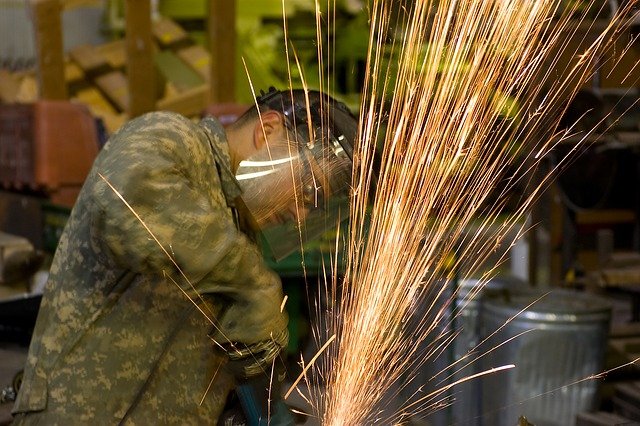Young construction workers still exposed to hazardous dusts
 A recently published study in the scientific journal, Occupational Medicine, shows that young stonemasons can and are still developing silicosis, a serious and deadly – yet entirely preventable – occupational lung disease.
A recently published study in the scientific journal, Occupational Medicine, shows that young stonemasons can and are still developing silicosis, a serious and deadly – yet entirely preventable – occupational lung disease.
The study looked in detail at six stonemasons, ranging in age from 24 to 39, who have developed this disease, one after just seven years in the trade, and all of whom are yet without any symptoms. When different types of stone are worked by cutting, grinding and chiselling, airborne dust is generated that can cause serious lung conditions if inhaled over time.
Some stonemasonry work also involves the application of fine decorative detail to stone, which often requires working very closely to the dust source. Breathing in the smaller respirable-sized fraction of the silica dust – respirable crystalline silica (RCS) – is what can result in the development of silicosis, as well as other serious lung diseases, including chronic obstructive pulmonary disease (COPD) and lung cancer.

Steve Perkins, CEO of BOHS
“This research study is hugely important because it highlights the devastating impact that exposure to hazardous dusts – simply by carrying out the regular tasks of their trades – can have on young construction workers’ lives today,” says Steve Perkins, chief executive of BOHS, the Chartered Society for Worker Health Protection. “It is estimated that over 500 construction workers die every year in the UK from respiratory diseases caused by exposure to silica dust, and yet these diseases can be prevented – by making sure health hazards are properly understood and recognised, risks are evaluated and exposures are effectively controlled.”
Also commenting on the study, Dr Alasdair Emslie, President of the Society of Occupational Medicine, states “The missed opportunity is that this is an old disease that we know how to control. It’s simply a case of getting the right expertise, into the right workplaces.”
Current occupational health guidelines recommend that only workers who report new or worsening respiratory symptoms be given an x-ray, but this study suggests that, in addition to controlling exposure to silica dust, regular radiological screening should be given to all workers at risk so that there is early detection of the disease. Dr Peter Reid, the lead author, from the Western General Hospital in Edinburgh, said “This study … makes the case for making sure that those at high risk are given x-rays at appropriate intervals, even when they don’t have symptoms. Early detection could save young lives.” Dr Reid emphasises, however, that “we should always remember that screening is not a substitute for good control of workplace exposure.”
Breathe Freely is a BOHS led initiative, in conjunction with some of the major players in the construction industry, which aims to prevent just such respiratory disease. Breathe Freely is about generating better awareness of the impact and causes of occupational ill-health in construction, and also effecting preventative solutions by providing information and guidance, and sharing best practice. Amongst the available resources is a series of fact sheets which set out main hazards, highest risks and preferred control options for all the key construction trades, which includes one for stonemasons.
[vc_row][vc_column width="2/3"][vc_column_text]
What makes us susceptible to burnout?
In this episode of the Safety & Health Podcast, ‘Burnout, stress and being human’, Heather Beach is joined by Stacy Thomson to discuss burnout, perfectionism and how to deal with burnout as an individual, as management and as an organisation.We provide an insight on how to tackle burnout and why mental health is such a taboo subject, particularly in the workplace.[/vc_column_text][/vc_column][vc_column width="1/3"][vc_single_image image="70883" img_size="medium" onclick="custom_link" link="https://www.shponline.co.uk/working-at-height-3/barbour-download-guide-to-working-at-height/"][/vc_column][/vc_row][vc_row][vc_column][vc_btn title="Listen now!" color="success" link="url:https%3A%2F%2Fwww.shponline.co.uk%2Fpodcasts%2Fwhat-makes-us-susceptible-to-burnout%2F|target:_blank"][/vc_column][/vc_row]
Young construction workers still exposed to hazardous dusts
Young construction workers are still being exposure to hazardous dust, shows new research that backs the BOHS Breathe Freely campaign.
Safety & Health Practitioner
SHP - Health and Safety News, Legislation, PPE, CPD and Resources Related Topics
Joinery firm fined for health and safety failings
Sole trader fined following workers’ exposure to wood dust
Health concerns and inspections for those who work with metalworking fluids or coolants



As a stonemason I believe that the industry needs to do more about the problem of dust.
Any worker exposed to any respirable dust should be better protected than they are. Workers are still dying unnecessarily or being rendered too sick &/or disabled to work. Wood dust per se is a group 1 carcinogen on the same level as asbestos. That from wood composite boards even more deadly due to the increased use of old heavily contaminated waste wood extracted from construction & demolition wastes from the demolition of old buildings, put back into new building products under the guise of ‘recycling’. Toxic and carcinogenic contaminants, including those previously banned from new building products because they were proven to cause cancers &other debilitating deadly diseases so as to protect worker health, other than chunks of metal, cannot be removed, it’s not financially viable too, so those too are being ‘recycled’ back into new building products. CRAZY!!! ALL will be emitted in dust workers are exposed to but not protected from, as no mention on MSDS. Wood machinists or those using power tools are exposed to copious amounts of very fine dust particles, some so fine they cannot be seen by naked eye, that stay permanently suspended in the air. It’s these that are the most harmful, as these are capable of passing through the alveoli of the lungs and into the bloodstream, so can affect any part of the body. It’s shocking that it is not compulsory for those in the wood trades to wear PPE. Most are lucky if a flimsy inadequate paper mask is provided. HSE are failing workers on many levels and lack robust enforcement. Most H & S organisations come down on the side of business/industry, choosing profits over worker health and lives. Most of our regulatory authorities lack backbone, lack up to date scientific evidence not influenced by those with a vested interest and are simply not fit for purpose! With unions that are no longer strong, standards are being allowed to fall. Workers will pay the price of industrial disease with their health and lives, whilst industry gets to keep the profits, regardless of the ill health and deaths that provided it. That’s what you call injustice, or is it corporate manslaughter? Time will tell!